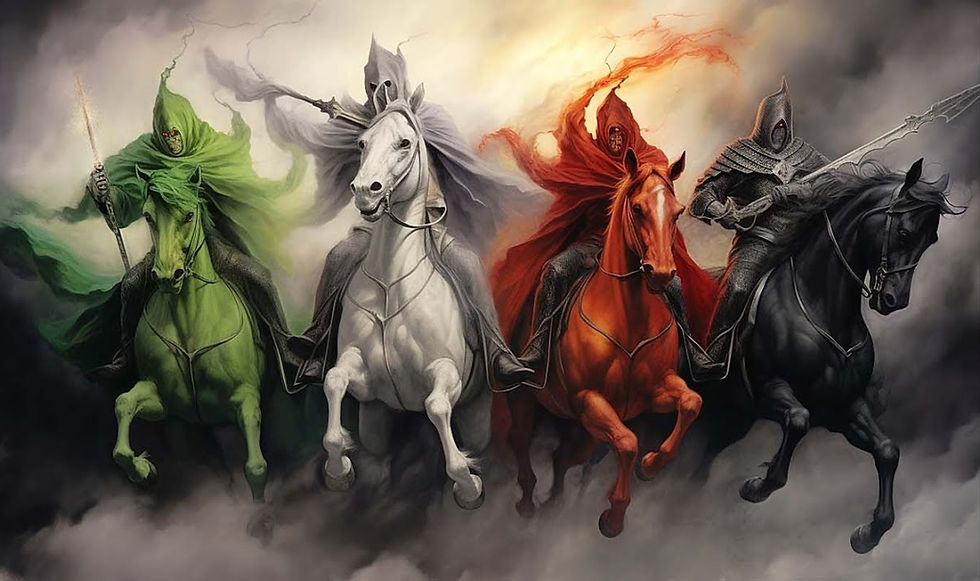Veiled in Light, Rooted in Darkness: The Hidden Satanic Symbols in Modern Worship
- carl1jimenez
- Apr 22
- 5 min read

What if the very symbols you revere in worship are not heavenly but hellish? What if the cross around your neck, the star on your wall, or the church steeple pointing to the sky are not signs of holiness, but echoes of ancient rites to demons? This is not conspiracy, it’s historical reality. Christianity, particularly in its Roman form, is a house built on borrowed altars, adorned with the same images once used to invoke pagan deities and demonic powers.
Modern Christianity has been infiltrated by symbols of Satanic origin, masked by tradition, and unknowingly embraced by millions.
1. The Cross: A Pagan Tool of Torture and Sun Worship
Long before Yahshua the Messiah was impaled, the cross was already a symbol in ancient Babylon and Egypt. The Ankh, known as the "cross of life," was carried by Egyptian g-ds. In Babylon, the T-shaped Tau was associated with Tammuz, the dead
g-d mourned in Ezekiel 8:14.
The Romans adopted crucifixion as a cruel method of execution. But it was Constantine, Rome’s sun-worshiping emperor, who merged pagan solar worship with early Christianity. He did not convert; he adapted. The cross became the emblem not of resurrection, but of control.
"They replaced the Tree of Life with the instrument of death."— Carlos Jimenez, historian and sacred name advocate
Today, the cross is displayed in homes, churches, and jewelry—ironically, idolized in violation of the Second Commandment (Exodus 20:4–5).
2. Obelisks and Church Steeples: Phallic Pillars of Ba’al
Obelisks originated in Egypt as symbols of Ra and the generative power of Osiris. These towering pillars represented fertility, resurrection, and sun worship. In Babylon and Canaan, similar pillars were raised in honor of Ba’al, the demon deity Yahweh commanded Yisrael to destroy (Deut. 12:2–3).
So why does the Vatican have an Egyptian obelisk in St. Peter’s Square? Why do churches worldwide rise with steeples modeled after these ancient pillars?
Because the Church absorbed pagan worship and cloaked it in Christian language. The very architecture pierces the heavens in defiance, echoing the Tower of Babel.
3. The Halo: Crown of the Sun
The glowing halo seen in paintings of “saints” and "Virgen's" originated in sun cults. Roman deities such as Mithras, Apollo, and Sol Invictus were often depicted with radiant crowns or halos to indicate divine light and authority.
Constantine worshiped Sol Invictus, the unconquered sun, and minted coins with the g-d’s image long after claiming conversion. The halo was inherited from the sun cult and retrofitted into "Christian" art to depict holiness, but its true origin is solar idolatry.
Origin of the Word "Halo"
The word Halo is not English but Greek and its original meaning is directly tied to the sun.
Greek: ἅλως (hálōs)
Meaning: disk, or more relevantly, a circular ring of light, like that which appears around the sun or moon during certain atmospheric conditions.
Latin: halo or halos was adopted with a similar meaning, a ring of light or a radiance.
Old English didn’t have this word; it entered the English language much later through Latin and Greek, especially in the post-Renaissance era when classical terms were being revived and adopted into theological and artistic vocabulary.
🔹 Connection to the Sun
In ancient times, especially in Greek and Roman art, solar deities like Helios or Apollo were often depicted with a radiant halo or sun disk around their heads, representing their divinity and power. This imagery was later absorbed into Catholic and Byzantine Christian art, where saints and even "Jesus" were depicted with a halo, literally a solar disk.
This is no coincidence. The halo, in its original context, is:
A visual representation of the sun.
A sign of divine light or power, originally from the sun gods.
A symbolic way of expressing illumination, glory, or transcendence, concepts tied to the sun in ancient belief systems.
4. Sunday Worship: The Day of the Sun-God
The 7th day Sabbath, sanctified by Yahweh, was changed by man, not by the Messiah. In 321 CE, Constantine issued a decree:
“On the venerable Day of the Sun, let the magistrates and people residing in cities rest...”
The Day of the Sun was sacred to Mithras and Sol Invictus. Sunday became the new day of worship, not because of Scripture, but because the Church sought political unity with Rome’s pagan majority. Yahshua and His disciples kept the Sabbath (Luke 4:16), but modern Christianity follows the calendar of Rome.
This is no minor shift, it is the changing of appointed times prophesied in Daniel 7:25, when the beast would “think to change times and law.”
5. The Rosary: Vain Repetition and Eastern Mysticism
Though revered in Catholic tradition, the rosary has its roots in Hinduism and Buddhism, where beads were used for mantras and meditation. The Catholic “Hail Mary” recitation reflects the vain repetitions condemned by Yahshua (Matthew 6:7).
Mary’s elevation to "Queen of Heaven" mirrors the ancient veneration of Ishtar, Astarte, and Semiramis, female deities worshipped with groves and idols.
6. The Hexagram: The Star of Remphan
The so-called “Star of David” is not from David. It is a hexagram—a symbol found on occult grimoires, alchemical texts, and used in witchcraft. Acts 7:43 rebukes the Yisraelites for taking up the “Star of your god Remphan”, an idol condemned by Yahweh.
In Kabbalah and Freemasonry, the hexagram is used to invoke demonic powers and symbolize the union of opposites (as above, so below). This symbol, falsely linked to Scripture, is flying over synagogues and churches today, unseen for what it truly is, a gateway to the occult.
7. The Fish (Ichthys): From Dagon to Christianity
The fish symbol, used on cars and jewelry, was sacred to Dagon, the Philistine fish g-d. Priests of Dagon wore fish-shaped miters, still seen today on Catholic bishops. While early believers used the fish as a covert sign, its deeper roots are not in Scripture, but in fertility cults and ocean deities.
A Call to Purge the Profane
This is not merely symbolic. This is spiritual warfare.
Yahweh is not mocked. He demands purity in worship (Leviticus 10:1–3). He warned Yisrael against mixing His Name with the practices of the nations. Yet modern Christianity has become a patchwork of paganism, where Satanic symbols lie hidden in plain sight, and the masses bow in ignorance.
“Come out of her, My people, lest you share in her sins, and lest you receive of her plagues.”— Revelation 18:4
You must choose: truth or tradition, light or shadow, Yahweh or Babylon. The deception is deep. The cost is eternal. And symbols will be their downfall.
By: Carlos Jimenez



Comments